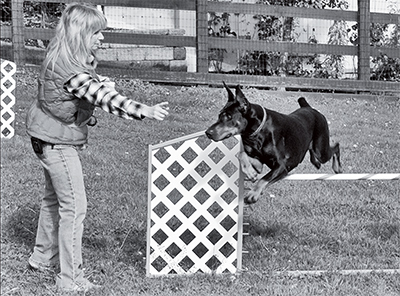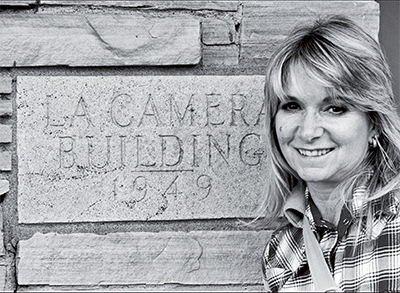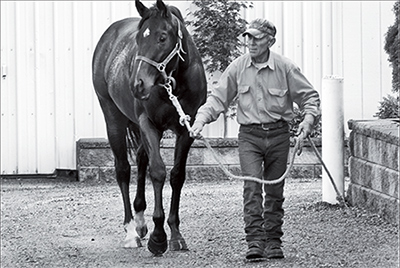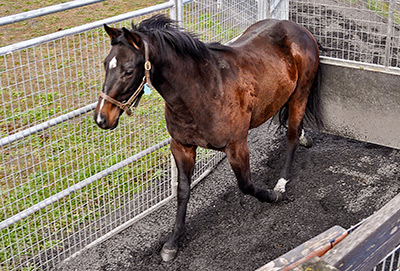El Dorado Farms Stallions — Sires of Champions!
ABRAAJ
Washington Champion 3YO INVESTED PROSPECT
Washington Champion Sprinter KAABRAAJ
COAST GUARD
Washington Champion 2YO SO LUCKY
PRIVATE GOLD
California Champion 3YO Male GOLD RUSH DANCER
![]()

41818 228th Avenue SE — Enumclaw, WA 98022 — P 360-825-7526 — F 360-825-6475
© 2001 - 2017 El Dorado Farms — Design by Gaelic Wolf Consulting
El Dorado Farms
Number One for a Reason
By Lezlie Wolff
There are clear reasons why El Dorado Farms has earned leading Washington breeder accolades. The formidable enterprise is comprised of eight farms in combination, all of which are owned and/or managed by Nina and Ron Hagen. Nina, a feisty Norwegian/Sicilian pixie with a feather woven into her fair locks is that perfect combination of determination, big picture mentality and energy from which success is manufactured.
Don’t think because Hagen’s left arm is immobilized from recent shoulder surgery that she might slow down for recovery. Over Halloween weekend, in addition to her standard daily responsibilities, she also oversaw a clinic at the farm, while simultaneously participating in dog agility trials at Argus Farm with her substantial Doberman, Mr. Vinnie.
Growing up in West Seattle, Hagen was a Kennedy Lancers’ gymnastics team member and would go on to coach the sport. Ambitious to graduate high school early, she took college classes during the summer, revealing a matchless drive and work ethic that would earn her distinction some years later.
Her character, she told me, comes from her Sicilian grandfather, Nino Anthony La Camera, whom she is named after. La Camera borrowed $20 to make the voyage from the old country to America. On arriving in New York, he found work coal mining, sending home $20 of the first $25 he earned, plus $2 for interest. That story stuck with Hagen, influencing the kind of business person she would become.
The only horse person in her family, Hagen revealed, “They didn’t know where I came from. Horses are just a very natural thing for me.”
During high school, Hagen took riding lessons at Inderwood Academy in Redmond and would casually ride with friends. That was the extent of her horse experience, until one day while working in her mother’s craft store, a woman walked in, and she and Hagen got to talking.
The customer told her, “There’s this guy who’s got horses . . .” You know what’s coming next, right? “This guy” had a couple of stallions and a bunch of mares who needed to be bred, but he had gotten hurt and needed a hand. Hagen thought, “How hard can it be?”
With nothing more than the instructions, “Wait till the mare is hot,” Hagen said she got every one of the mares bred without getting anyone kicked. She was 21 at the time. Thirty-four years later, Hagen, and her husband Ron, is enjoying her third consecutive year as leading Washington breeder and has the shoulder issues to show for it.
Being leading breeder three years in a row, she said, is amazing! Hagen attributes her success to her passion, high standards, attention to every detail and the quality of care she and her team provide to every individual horse. The four foundation principles to her operation are: safety first, use only the best equipment and supplies, exercise absolute fairness, and practice compassionate communication for horses, as well as humans.
Hagen breeds for stakes winners and treats every horse and foal as one and the same. She is fond of saying, “The eye of the master trains the beast, feeds the beast, grows the beast. You have to look at these guys every day and that’s exactly what we do.” She and her crew provide ’round the clock, hands on, individual care for each equine. Hagen breeds every mare for her best shot of producing a stakes horse. Her requirements for choosing stallions are family, race record and conformation, as well as their statistics for siring two- or three-year-olds.
As for training philosophy, she says you want to teach trust from the moment you pull them out of their moms. People who don’t touch the babies or start them poorly create problems for the horse and the handlers down the road. With young horses, she builds a solid foundation of trust and respect through communication and fairness.
The cornerstone of the Hagen operation begins with nutrition. She provides a high quality, balanced feeding program for each horse, avoiding OCD (osteochondrosis) issues which, she says, occur in utero. She gets her hay tested regularly and works in collaboration with her feed company (LMF) to make sure quality and consistency are maintained.
Hagen looks for ways to keep everybody in business by making it as affordable as possible. “You try to do a good job for everybody, so they don’t have any unforeseen costs,” she said. She works to keep the owners’ bills down, while maintaining her standards and sometimes absorbing the differences herself.
In 2005, Hagen added a Centaur Equineciser (equinecisers.com) to the farm and is impressed with the results. Whether horses are broke two-year-olds about to begin their first season, a horse recovering from an injury or just one being reconditioned from time off, after 60 days on the Equineciser, Hagen says, the trainer better be prepared for “a pretty darn fit horse.”
The Equineciser is like a revolving door. The horse works at liberty (no training equipment or rider) between two panels about three horse lengths apart which move in a circle like a round pen. The operator sets the direction and pace – walk, trot, canter and stop. There are spaces for four horses, but Hagen only puts in two at a time, opposite one another.
She equated the benefits of an Equineciser workout to hiking up Mt. Peak, a small volcano she pointed to out her kitchen window. Mt. Peak’s steep incline rises 1,000 feet in just one mile. That is where Hagen reconditioned after her first shoulder surgery, two years ago. She said that climb alone was enough to get her fit, no need for her to carry a pack.
Likewise, a horse coming off a layup will benefit by working in the Equineciser without weight on his back. Sessions are 15 minutes each direction for 45 to 60 days, after which horses are typically ready to breeze in approximately ten days after returning to the track, Hagen stated. All this for half the price of getting a horse fit at the track.
The gentle, concussive impact increases bone density while building up top line, as well as strengthening soft tissue and joints. Muscle develops as each leg drives through the 70/30 percent rubber and sand footing. Everything is getting stressed in a controlled environment, she pointed out.
Hagen also emphasized the advantage of watching each leg work. Rarely, she said, do you find a rider who knows what is going on with any individual leg of the horse he or she is riding. Injuries happen without that acute sensitivity. The Equineciser gives you the opportunity to methodically examine every aspect of the horse’s body at work.
I spoke with “X-ray Jim” Jorgensen, from Traber, Bergsma, Simkins Inc., about equine shoulder injuries and how the Equineciser might prevent them. He informed that this type of injury seems to occur with two- and three-year-olds who go to the track and train, they may or may not race, and then they stop work. Maybe they got sore, he suggested, and were turned out in a small paddock or laid up in a stall. Meanwhile, the bone density dissipates during the layoff.
“We think we’ve done that horse good by giving him the time off,” Jorgensen said. “But then we put him right back into training without letting him build that bone density back up.” He recommends, after a layoff, give the horse some pasture turnout where it can naturally build up bone density on its own by running around. Then use the Equineciser to slowly build up strength over a period of time.
Jorgensen reported that x-rays of the humerus (shoulder joint) are often showing calluses which indicate a micro-fracture. He and Hagen studied two horses with such calluses. Both horses received shockwave therapy. One was worked in the Equineciser for 60 days, while the other was on stall rest and turned out in a small paddock. After the 60 day period, both were again x-rayed, which showed the calluses were gone.
However, as Hagen pointed out, the horse that was worked in the Equineciser was fit and ready to return to work, whereas the stall rested horse was very soft and not yet ready to work.
Leading trainer Frank Lucarelli confirmed the Equineciser results. “I think it’s just fabulous for rehab horses,” he told me on the phone from California. He said his stakes horses live on it during their breaks. One horse, after double knee surgery, had six weeks on the Equineciser and came back ready to breeze. “It just cuts down on that hard training with a rider on them and the horse bouncing around weakening things.”
He told me he just had four horses shipped to Golden Gate Fields who had had 45 days on it, and they all breezed fabulously within a week. “It’s a wonderful thing to get horses started off a layoff.”
Hagen wants racing people and horses to thrive. She said, “If the only difference I make by being here on this earth is showing people you can do this and avoid a lot of bad things, then good.” It is clear that her success comes from her dedication to provide the best quality care for each individual.
Meanwhile, she told me, with her arm in a sling, “Everything takes a lot longer.” That didn’t occur to her when she agreed to breed those stallions and mares all those years ago.
Check out El Dorado Farms on the web at eldoradofarms.net and on Facebook.
Lezlie Wolff gave her soul to the Thoroughbred while rubbing Lucky Seas at Longacres during her teenage years, and she has been in service to them ever since. She works as an ambassador for horse racing, bringing stories to those who have never experienced it and endeavoring to give them something profoundly positive to take with them. She contributes an occasional story to Washington Thoroughbred and runs an exclusive riding school at Heritage Farm Training Center in Kent. Outside of the barn, she works in the local and international world of microfinance and microenterprise and is a dedicated supporter of independent radio. You can friend her on Facebook.



